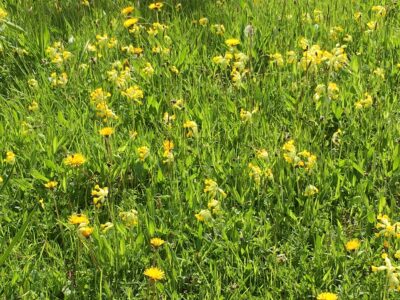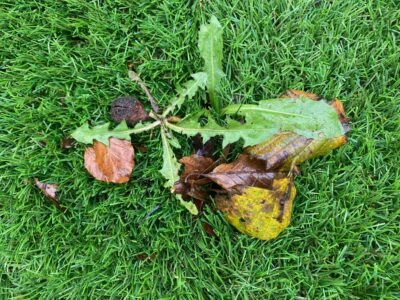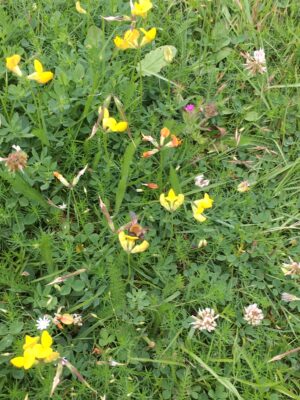Replacing an existing lawn with a plastic carpet is a bit like taking out your kitchen and putting in pretend appliances that look the part but don’t work? And maybe go on to create havoc or worse inside your home? Or Like buying a car without an engine and parking it on the drive because it looks like the real thing? And maybe it will turn into an ecocide disaster before your eyes. Choosing fake grass is bonkers. But more worrying it has huge implications for the environment. Honestly, you might as well move somewhere without a garden if you don’t want to bother with looking after it.
Apart from the questions regarding recycling at the end of its life and indeed the huge concerns regarding the potential degradation into micro-plastic particles that get into the soil, the rivers and oceans and ultimately into the food chain, there are so many other reasons to really think twice before laying plastic grass. Here are a few things to consider before you make your choice.
- First, it’s not natural – if you love being outside in nature and really want your garden to count towards supporting and nurturing wildlife and the environment, then choosing plastic grass is a bad choice. Even if you don’t want a proper lawn, fake grass is not the answer. Many years ago, we removed all my lawn and planted the areas with trees, perennials, shrubs and groundcover. I don’t have the bother of mowing or maintaining a lawn and I have a lovely garden without a fake lawn. There are so many other solutions without resorting to outdoor carpets.
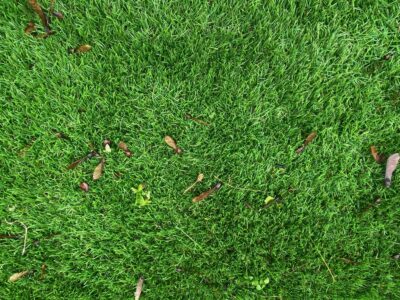
Plastic grass.
- Fake grass gets hot – When the sun comes out, especially in the summer, the plastic grass heats up, in fact it can get very, very hot, potentially causing a risk to pets, wildlife and any barefoot visitors. Not to mention any fumes that may be released by the hot materials. There’s a question mark over whether chemicals are released from the hot plastic and how this might accelerate the breakdown of the materials used to manufacture your fake grass.
- Weeds still grow in artificial lawns – It doesn’t take long for debris to build up within the plastic ‘grass’ matrix, providing enough substrate for weeds to germinate. So, you will still need to weed your fake grass.

Weeds grow on fake grass.
- Artificial lawns need cleaning – Just like a carpet or a rug, you will need to clean your plastic lawn. Unlike a real lawn where any debris is in close contact with the soil and rain can wash it away and the natural soil microbes can work on it to reduce it to nutrients, anything that falls on a fake lawn will need cleaning off. That includes bird droppings, dog poo and anything else that might otherwise taint your ‘lawn’. And YUCK – imagine blasting that away with the hose, or pressure washer. You might have to get out there with a power washer much more often that you think – so is a fake lawn as low-maintenance as you think??
- Fake grass needs raking – Foot traffic over an artificial lawn will flatten the fibres, so to keep it spruced up and looking grass like you will need to fluff it up, or rake it. When grass grows and is cut the plants are constantly renewing and refreshing the grass, but plastic grass doesn’t grow, so the same blades of ‘grass’ remain and need care and attention. Not to mention the raking required if your artificial lawn is under a tree that drops its leaves, flowers, fruit, seeds, nuts and even bugs throughout the year.
- Artificial lawns don’t last forever – Depending on the quality, they wear out, they break down and they can also ruck-up, loosen and become undermined by subsidence, burrowing creatures or even flooding and drought. So, you could find that you need to replace your expensive outdoor carpet quicker than you think. Some experts suggest you will need a new fake lawn every 7-10 years. Imagine the cost?? And that then raises the question of how do you recycle it?? Or can it be re-used. Let’s be honest, it is much more likely to end up in landfill. Not to mention the cost of buying it in the first place and indeed replacing it at a later date.
- Plastic grass divides the layers of the garden – Fake grass deprives your soil of a connection to the rest of the garden. It creates a barrier between the soil and the air, interfering with the natural connections in the garden. Think about the worms when they rise through the soil and hit the plastic layer above. Normally the soil microbes live and breathe around the grass roots keeping the garden healthy and alive, a plastic carpet interferes with this. And constant foot traffic above compacts the soil below making it impossible for creatures to live there. In time this soil can become stale, stagnant and inhospitable to nature.
- Artificial grass isn’t the eco option – you might think that something that doesn’t need mowing, treating for weeds or even fertilised is more eco than a traditional lawn. But is it?? What about the resources needed to manufacture vast carpets of plastic grass?? As it breaks down will it release micro-plastics or other chemical compounds into the environment? Weeds still germinate on an artificial lawn. And of course, you don’t necessarily need to treat a lawn with chemicals. If you mow paths through a lawn and leave the rest to grow you can reduce mowing and maintenance too.

Wildflower lawn.
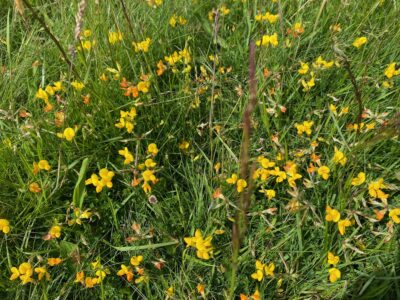
There are so many better ways to create a low maintenance and very beautiful area in our gardens without using plastic lawns. Of course, first and foremost a real lawn or a flower lawn or a wildflower patch is a lovely alternative, add plug plants of Bird’s Foot Trefoil, clover and other wildflowers. Alternatively, why not consider planting the area with low growing ground cover plants, things that will creep and cover the patch and flower too. You could loose pave by creating a hopscotch paving pattern with gaps filled with gravel between the slabs and then plant up the pockets between the paving with flowering herbs like thyme. Or use gravel and allow your favourite plants to self-seed there. This allows the garden to breathe, the rain water to drain away and the soil to connect with the rest of the garden. It might need a little more care and attention but the benefit to pollinators, birds and other wildlife far outweighs the minimal care it needs. We grow plants for a reason, they help our gardens breathe and bring pleasure and wonder into our world. A fake lawn suffocates the garden and adds nothing to the wonderful equation, where gardening gardens and plants equal peace, tranquillity and pleasure.
